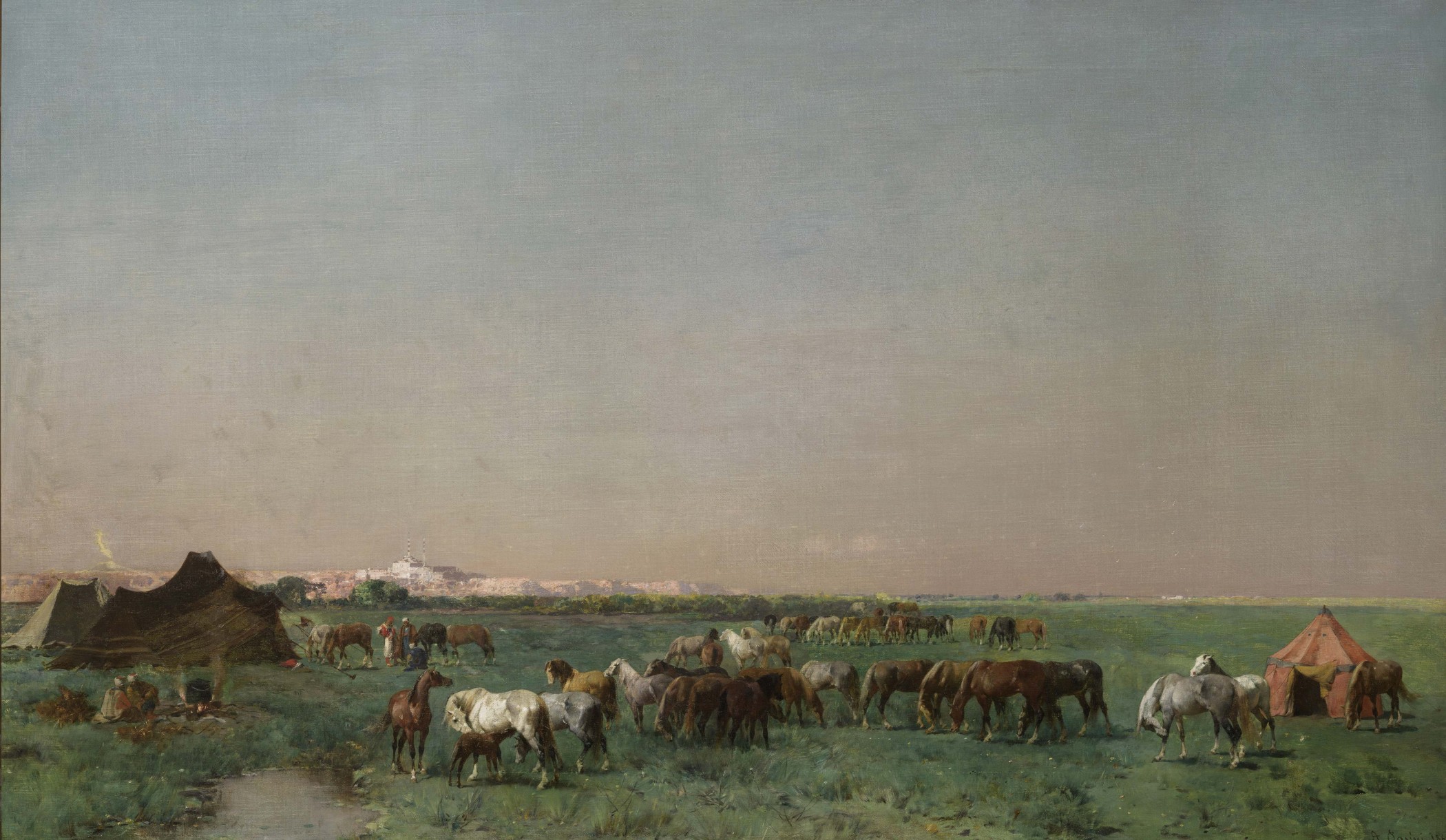Alberto Pasini
(Busseto 1826 - 1899 Turin)
Resting Horses and Voyagers outside Istanbul, 1869
oil on canvas, 77 x 127 cm (30.31 x 50.00 inches)
Alberto Pasini
(Busseto 1826 - 1899 Turin)
Resting Horses and Voyagers outside Istanbul, 1869
oil on canvas, 77 x 127 cm (30.31 x 50.00 inches)
Re: 860
Provenance: Gussoni collection, Milan
AAVV, Catalogo Raccolta Gussoni, Galleria Dedalo, Milan 1934, no. 117, plate LIII
V. Botteri Cardoso, Pasini, Milan, 1991, p. 279, n. 372
"The painter of the Orient, of the silvery light of the Bosporus, of the smiling sky of the Golden Horn; of the imposing forests of Lebanon; of the soft green of the plains of Syria and the fiery expanses of Persia, where he hunts with hawks; of the mysterious coloured shadows, warm and transparent in their very darkness, in the interiors of mosques and palaces; of the charm of the vibrant, bewitching and voluptuous colour of oriental nature". This is how Alberto Pasini was described, the day after his death, by his friend and critic Giulio Carotti, in an article that appeared 'in memoriam' in the magazine Emporium[1]. Moreover, Carotti's flattering judgement of the artist was widely shared in Italy and Europe: Pasini was unanimously recognised as the greatest Italian 'Orientalist' painter, a prime witness to the interest and attraction that the lands of the Middle East aroused in the minds of Europeans, at the time of colonial invasions as well as the great archaeological discoveries on the Bosporus[2].
Pasini, after a long training at the Academy of Fine Arts in Parma, had completed his apprenticeship in Paris by entering the workshop of Eugène Cicéri, an exponent of the Barbizon school. It was 1852, the same year that Napoleon III had established the Second French Empire, at the time limited to the mother country and Algeria, but about to expand very quickly. In 1854, Pasini began working with the famous Orientalist painter Théodore Chassériau, who recommended him to the diplomat Nicolas Prosper Bourée: this was the turning point in the career of our artist, who was called to accompany Bourée on a year-and-a-half-long colonial mission to Persia, Turkey, Arabia and Egypt. The East became an inexhaustible source of inspiration for Pasini: above all on an emotional and personal level, as evidenced by his long friendship with the Shah of Persia. His art, however, distances itself from the romantic orientalism of the first half of the 19th century: Delacroix, Gerome, Chassériau himself - and in Italy Hayez and later Domenico Morelli - had told tales of a literary and therefore invented Orient, an ideal 'elsewhere' that was also an implicit criticism of the hegemony in Europe of bourgeois culture, which they obviously despised. Pasini, on the other hand, is a realist painter, trained on the models of the Barbizon masters, and is entrusted by the French government with the task of documenting the nature of the territories he visits, at a time when taking photographs in open spaces was still a very difficult operation. The exactness of the vision of his landscapes, almost always taken at eye level to illustrate more clearly the humanity that inhabited them and the lifestyles that were proposed in the places described, led the artist to formal results not far removed from those that Gustave Courbet and Jean-François Millet achieved at the same time in their narration of the everyday life of rural France.
Our painting is signed and dated 1869: it therefore belongs to the period following the painter's second stay in Istanbul two years earlier[3]. And the city that unites the two continents can indeed be seen in the background of this magnificent landscape, with the profile of St. Sophia in the centre and the Seraglio Promontory on the right. Yet Istanbul, the metropolis "with its imposing domes and elegant minarets that one would say were put there to support the vault of heaven", according to the description Pasini himself left in one of his letters[4], is here observed from afar, from the pastures of Anatolia, by the tents and fires of the herdsmen. The artist's attention is devoted to the horses' profiles, rendered with darting strokes of colour and illuminated by the warm, meridian light of the south. Pasini's 'verismo' anticipates by about twenty years the literary experiments of Giovanni Verga and Luigi Capuana, and gives rise here to a true suspension of time, between the turbaned old men, who emanate a sense of wisdom from their appearance, and the movement of the curtains blown by the everlasting wind. This timeless and dreamy character is the same as that found in a slightly earlier work by the painter: the Caravan by the Red Sea, a canvas of 1864 now in the Galleria d'arte moderna of Palazzo Pitti in Florence[5]: in both paintings, the figures are rendered with a perfunctory stroke, but at the same time with a formidable attention to minute detail. It is nevertheless the main prerogative of Pasini's art, rightly celebrated in the Salons and rewarded in 1878 by the Third French Republic with the appointment as an officer of the Legion of Honour.
[1] G. Carotti, Artisti contemporanei: Alberto Pasini. In memoriam, in “Emporium”, X, 1899, 60 pp. 485-504 (the quotation is on p. 485).
[2] On Pasini: V. Botteri Cardoso, Pasini, Genoa 1991; Pasini e l'Oriente. Luci e colori di terre lontane, edited by P. Serafini and S. Roffi, exhibition catalogue (Maminao di Traversetolo, Fondazione Magnani-Rocca, 17 March - 1 July 2018), Cinisello Balsamo, Milan 2018
[3] Of the painting, known until now only through a photograph from 1934, no date was known. This reappeared on the occasion of the recent cleaning. Botteri Cardoso included the canvas in the group of works executed by the painter between 1860 and 1867: Botteri Cardoso cit., 1991, p. 279, n. 372

